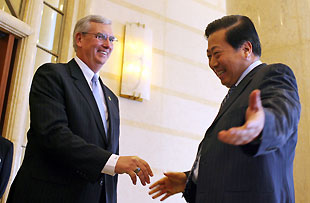Environmental protection goals not met
By Sun Xiaohua in Beijing and Yin Ping in Shanghai (China Daily)
Updated: 2006-04-13 05:47
High consumption of energy and power in the 10th Five-Year Plan period
(2000-05), especially after 2002, has led to some environmental protection goals
not being met in this period, the State Environmental Protection Administration
(SEPA) said yesterday in Beijing.
 |
|
| U.S.
Environmental Protection Agency administrator Stephen Johnson (L) is
welcomed by China's State Environment Protection Bureau Minister Zhou
Shengxian at a meeting in Beijing April 10, 2006. [Reuters] |
| Among the 20 environmental goals set for the 10th Five-Year Plan, eight have
not been achieved, said Zou Shoumin, deputy head of the Chinese Academy for
Environmental Planning (CAEP) under SEPA.
The five-year plan stipulated that discharges of sulphur dioxide should be
cut by 10 per cent, but compared with discharge levels from 2000, levels of the
pollutant increased by 27 per cent in 2005.
Another six goals, such as reducing the discharge of carbon dioxide and
industrial solid waste, or increasing the capabilities of wastewater treatments,
have not been fully realized.
"We worked out the 10th Five-Year Plan on the basis of economic levels in
1998 and 1999," Zou said. "However, after 2002, China witnessed rapid
development after the Asian financial crisis of 1997."
CAEP expected that in 2005, China's energy consumption would not exceed 1.5
billion tons standard coal. However, the country had used 2.2 billion tons that
year.
Thermal-power generation, as the biggest consumer of coal and discharger of
sulphur dioxide, has seen growth far beyond the plan. According to the plan, in
2005, the installed capability of thermo-power generation was about 400
megawatts. But the de-facto installed capability reached more than 500
megawatts.
"Energy consumption and thermo-power generation development made a major
contribution to the failure of sulphur dioxide reductions," Zou said.
"But during that period, the country's environmental
status generally improved, although the problem of environmental pollution
remains pressing," said Zhu Jianping, deputy director of China National
Environmental Monitoring Centre.
|